Marcel Duchamp Biography
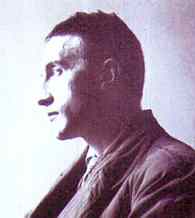
Marcel Duchamp was born on 28 July 1887, in Blainville, near Rouen, France, into the family of a well to-do-notary. Both parents respected and encouraged cultural activities; four of their children became artists - Raymond Duchamp-Villon (1876-1918), sculptor, Suzanne Duchamp, poetess and artist, better known under the name of Crotti, Marcel Duchamp himself, and the half brother of the three, Gaston, painter, who is known as Jacques Villon.
In 1904, Marcel came to Paris to join his two elder brothers, who had given up law and medicine in favor of artistic careers. Marcel entered the Académie Julian, but did not attend classes much. Between 1906 and 1910 Duchamp hesitated between different styles, the most influential on him were Fauvism (Paradise, 1910-11; Portrait of Dr. R. Dumouchel, 1910) and Cubism (Chess Players, 1911).
In 1911-13, he was a member in the painters' group known as the "Golden Section", together with Roger de la Fresnaye, Fernand Léger, Jean Metzinger, Juan Gris, Alexander Archipenko, and others. Using cubist techniques Duchamp tried to show movement on canvas, which makes him close to Futurists. Doubling, overlaying images fix different phases of the movement of a figure on canvas (Sad Young Man in a Train. 1911; Nude Descending a Staircase. 1912; King and Queen Surrounded by Swift Nudes. 1912). The Nude Descending a Staircase, shown at the Salon des Indépendants, aroused sharp criticism even among the Cubists, to say nothing about the general public. In 1913, the picture was the hit of the New York Armory Show; it scandalized the American public to such a degree that it made the artist popular overnight. While most of the viewers were outraged with the exhibited pictures, especially with the Nude, the others were sincerely delighted by the European break with academic and traditional art.
In his works of 1914-15 the complicated structures are pushed out by laconic, rigid mechanical forms, which created contradicting correlations of volume and flatness (Bride, 1912; Chocolate Grinder, 1914). When Duchamp arrived in NY in 1915, he was pleasantly surprised to find that he was a famous man. On his arrival, he met Walter and Louise Arensberg, who became his main patrons and collectors. (Walter Arensberg's impressive collection of modern art, including all of the numerous Duchamp works, is in the Philadelphia Museum of Art today.)
In the United States Marcel Duchamp and his friend Francis Picabia soon became the center of the circle of painters around the Stieglitz gallery. The group had adopted an anti-art attitude and was thus a movement parallel to the Zurich Dadaism.
In 1913-14 putting painting aside, Duchamp exhibited his first ready-mades – manufactured banal objects of every-day life, which taken out of place and their prime usage, demonstrated abilities of abstract forms. Was it the search for new forms in art or just a wish to make scandals? Difficult to say. But they were definitely to demonstrate Duchamp's profound contempt for the bourgeois conception of art. Thus in 1917 at the exhibition of a new Society for Independent Artists Duchamp submitted the Fountain. The "Fountain" was a urinal, and Duchamp did not dare sign it with his real name, instead he used the pseudonym R. Mutt.
In 1915-23 the artist worked on a big composition'The Large Glass: The Bride Stripped Bare by Her Bachelors, Even.' This composition is in mixed and complicated techniques - oil and varnish painting on glass, collage of paper, foil and wire, some shapes obtained by chance effects, such as dust blown on to the drawings - and is supposed to symbolize the circulation of instinctive wishes and hidden work of unconscious. In 1923 the work was officially declared unfinished.
Around 1920, Duchamp proceeded with his ready-mades, but they became more complicated. Instead of buying manufactured objects to inscribe and sign, Duchamp made several constructions, such as Fresh Widow; The Brawl at Austerlitz.
After 1923 Duchamp actually left art and devoted himself to playing chess, art critic and literary activities. Together with Katherina Dreier he founded the "Société anonyme" for the propagation of modern art in America; preference was given to anti-traditional, cubist, futurist and dadaist works. From 1942 to 1944, together with Max Ernst and André Breton, he edited the surrealist periodical "VVV", in New York.
Attempts to understand Duchamp's works have resulted in multiple books and magazine articles. "Duchamp himself calmly tolerated all interpretations of his art, even the most far-fetched, since he was interested in them as the creations of the people who formulated them, although not necessarily as the truth." (Marcel Duchamp. Art as Anti-Art. By Janis Mink. Taschen Verlag. 2000. p. 8) But was there any'truth' and any reason for his works? Thus about one of his most famous ready-mades Bicycle Wheel, he sincerely said, that he liked spinning it occasionally with his hand, just to watch it, "I enjoyed looking at it, just as I enjoy looking at the flames dancing in a fireplace."
Though the least spectacular, Marcel Duchamp became one of the most influential artists of the twentieth century. His experiments in the field of optical illusions, cinema, moving constructions and ready-mades paved the road for new artistic forms such as op-art, kinetic art, installation. At the end of his life Duchamp became an idol of the new generation of avant-garde American artists.
Bibliography
:
Robert Lebel sur Marcel Duchamp. Trianon Press. 1959.
Marcel Duchamp. By A. Schwarz. Paris. 1974.
Duchamp ou le Grand Fictif. By L.Clair. Paris. 1975.
Joseph Cornell/Marcel Duchamp...Resonance by Susan Davidson, Anne D'Harnoncourt (Introduction), Lynda Roscoe Hartigan, Ann Temkin, Walter Hopps, Ecke Bonk, Joseph Cornell, Marcel Duchamp. Hatje Cantz Publishers, 1999.
The Bride and the Bachelors: The Heretical Courtship in Modern Art by Calvin Tomkins. Penguin USA, 1976.
Dialogues With Marcel Duchamp by Pierre Cabanne, Marcel Duchamp, Robert Motherwell (Designer). DaCapo Press, 1988.
Marcel Duchamp: The Art of Making Art in the Age of Mechanical Reproduction by Francis M. Naumann, Marcel Duchamp. Harry N Abrams, 1999.
Affectionately, Marcel: The Selected Correspondence of Marcel Duchamp by Marcel Duchamp, Francis M. Naumann (Editor), Hector Obalk (Editor), Jill Taylor (Translator). Ludion, 2000.
Marcel Duchamp by Dawn Ades, Neil Cox (Contributor), David Hopkins, Marcel Duchamp, Da Ades. Thames & Hudson, 1999.
Kant after Duchamp (October Books) by Thierry De Duve. MIT Press, 1998.
Infinite Regress: Marcel Duchamp 1910-1941 (October Books) by David Joselit. MIT Press, 2001.
The Private Worlds of Marcel Duchamp: Desire, Liberation, and the Self in Modern Culture by Jerrold Seigel. University of California Press, 1997.
Duchamp: Great Modern Masters (Great Modern Masters Series) by Marcel Duchamp, Alberto Curotto (Translator), Jose Maria Faerna (Editor). Abradale Press, 1996.
The Complete Works of Marcel Duchamp (2 Volumes in 1) by Arturo Schwarz. Delano Greenidge Editions, 2001.
Marcel Duchamp: The Bachelor Stripped Bare: A Biography by Alice Goldfarb Marquis. MFA Publications, 2002.
- Paradise.
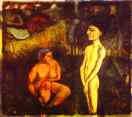
1910-11. Oil on canvas. 114.5 x 128.5 cm. The Philadelphia Museum of Art, Philadelphia, PA, USA.
- Portrait Of Dr. R. Dumouchel.
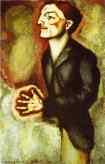
1910. Oil on canvas. 100 x 65 cm. The Philadelphia Museum of Art, Philadelphia, PA, USA.
- Portrait Of Chess Players/Portrait De Joueurs D'Echecs.
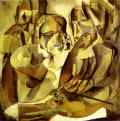
1911. Oil on canvas 108 x 101 cm. The Philadelphia Museum of Art, Philadelphia, PA, USA.
- Sad Young Man In A Train/ Jeune Homme Triste Dans Un Train.
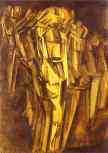
Oil on canvas, affixed to cardboard. 100 x 73 cm. Peggy Guggenheim Foundation, Venice, Italy.
- Nude Descending A Staircase (No.2)/Nu Descendant Un Escalier. No.2.
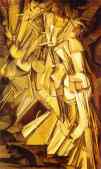
1912. Oil on canvas 147.5 x 89 cm. The Philadelphia Museum of Art, Philadelphia, PA, USA.
- Bride/ Mariée.

Oil on canvas. 89.5 x 55.25 cm. The Philadelphia Museum of Art, Philadelphia, PA, USA.